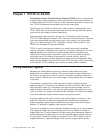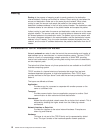
Subnetworks and Subnet Masks
A class A, B, or C network can be further divided into multiple smaller networks that
are called subnetworks. These smaller networks are identified or addressed by a
subnet ID. With an Internet address of any class we can subdivide the host ID bits
to provide identification of the subnet ID. The subnetwork is identified by combining
the network ID and subnet ID. This combining of the network ID and subnet ID is
defined as a subnet mask.
A subnet mask further specifies for the host the exact number of bits that are to be
used for the subnet ID and the number to be used for the host ID. Overall, subnet
masks make it easier to divide a single network without wasting internet addresses
and as a result, increase the performance of the network.
For example, consider a class B internet address that has a network ID portion
equal to 144.22. This class B address has 16 bits allocated for the network ID and
16 bits allocated for the host ID as shown in Figure 3:
If the high-order byte of the host ID portion of the class B internet address is used
for a subnet ID, then the host ID can be divided into an 8-bit subnet ID and an 8-bit
host ID as shown in Figure 4:
The class B 144.22 network, using this identification of the subnet ID, can be
divided into 254 subnetworks ranging from 144.22.1 through 144.22.254.
The subnet mask that identifies the subnetwork in this example would be
255.255.255.0.
Therefore, an internet address can be shown as consisting of the following:
internet address = <network id><subnet id><host id>
Figure 3. Standard Class B
Figure 4. Subnetted Class B
Figure 5. Subnetted Class B with Subnetworks
6 OS/400 TCP/IP Configuration and Reference V4R4


















